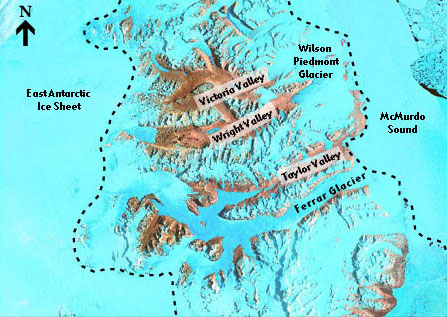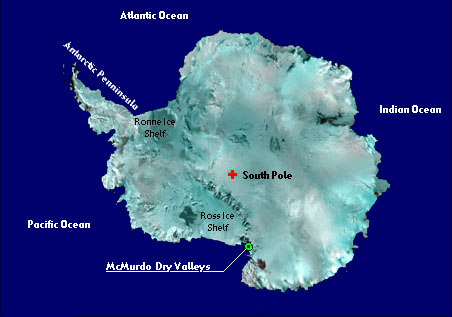Home|Glossary|Links|Journal
| Maps
Heading South! (OLD REPORT - November 2002)
|
Deserts.
When I think of such arid zones, I imagine shifting sands, prickly
cacti, and intense heat, the kind that seems to suck all the
water from your body in sweat as if trying to make you a desert
too.
But one of the driest places
on earth has temperatures that plummet to minus 50 degrees Fahrenheit
- no wind chill factor. Glaciers protrude into the region creating
walls of ice that are as high as 10 stories. The paltry 10 cm
of water the region does get each year on average falls as snow.
No cacti and essentially no other terrestrial vegetation for that matter,
are anywhere to be found.
The valleys that make up this
desert, which is among the coldest on earth, are collectively
known as the McMurdo Dry Valleys, and they are located on the planet's
southernmost continent, Antarctica.
|

The Dry Valleys
|
Only on a continent like Antarctica -
98 to 99 percent of whose surface is covered with ice - would such a barren place be referred
to as an oasis. But with an area approximately one and a half times
the size of Rhode Island, the Dry Valleys form the largest ice-free
zone that the continent has, and as such, are a refuge of bare rock
and soil.

Antarctica
|
The towering peaks of the Transantarctic
Mountain Range prevent the Eastern Antarctic ice sheet from
pushing into the Dry Valleys while the Wilson Piedmont Glacier
helps keep moisture from nearby McMurdo Sound out. Cold air,
such as that found in Antarctica, cannot hold as much water
vapor as warmer air to start out with, and when winds push the
air over mountains, it rises and cools even further. As this
happens, the moisture the air does contain drops out. By the
time it reaches the other side it's dry and the area downwind
of the mountain is said to be in a precipitation shadow.
|
"The
only deserts are
those of imagination"
Paolo
Lugari,
founder of Gaviotas,
a sustainable community in Colombia
|
|
Strangely though, at the
same time the Dry Valleys are incredibly dry, when compared with the
rest of the frozen continent, the valleys are also remarkably wet.
During the southern hemisphere's summer, which occurs during the northern
hemisphere's winter, temperatures rise enough for glacial melting
to occur. The meltwater forms streams that empty into some of the only lakes
in the world with a permanent cover of ice
Next>>
|


